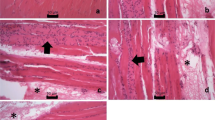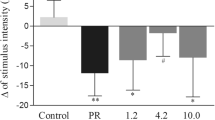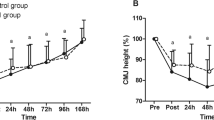Abstract
The aim of this study was to test, between two bouts of exercise, the effects of light-emitting diode (LED) therapy and cryotherapy regarding muscle damage, inflammation, and performance. Male Wistar rats were allocated in four groups: control, passive recovery (PR), cryotherapy (Cryo), and LED therapy. The animals were submitted to 45 min of swimming exercise followed by 25 min of recovery and then a second bout of either 45 min of exercise (muscle damage analysis) or time to exhaustion (performance). During the rest intervals, the rats were kept in passive rest (PR), submitted to cold water immersion (10 min, 10 °C) or LED therapy (940 nm, 4 J/cm2) of the gastrocnemius muscle. Blood samples were collected to analyze creatine kinase activity (CK), C-reactive protein (CRP), and leukocyte counts. The soleus muscles were evaluated histologically. Time to exhaustion was recorded during the second bout of exercise. After a second bout of 45 min, the results demonstrated leukocytosis in the PR and Cryo groups. Neutrophil counts were increased in all test groups. CK levels were increased in the Cryo group. CRP was increased in PR animals. The PR group presented a high frequency of necrosis, but the LED group had fewer necrotic areas. Edema formation was prevented, and fewer areas of inflammatory cells were observed in the LED group. The time to exhaustion was greater in both the LED and Cryo groups, without differences in CK levels. CRP was decreased in LED animals. We conclude that LED therapy and cryotherapy can improve performance, although LED therapy is more efficient in preventing muscle damage and local and systemic inflammation.




Similar content being viewed by others
References
Mohr M, Krustrup P, Bangsbo J (2003) Match performance of high-standard soccer players with special reference to development of fatigue. J Sports Sci 21(7):519–528. doi:10.1080/0264041031000071182
Chelly MS, Hermassi S, Aouadi R, Khalifa R, Van den Tillaar R, Chamari K, Shephard RJ (2011) Match analysis of elite adolescent team handball players. J Strength Cond Res 25(9):2410–2417. doi:10.1519/JSC.0b013e3182030e43
Bangsbo J, Iaia FM, Krustrup P (2007) Metabolic response and fatigue in soccer. Int J Sports Physiol Perform 2(2):111–127
Reilly T, Drust B, Clarke N (2008) Muscle fatigue during football match-play. Sports Med 38(5):357–367
Mendez-Villanueva A, Buchheit M, Simpson B, Bourdon PC (2013) Match play intensity distribution in youth soccer. Int J Sports Med 34(2):101–110. doi:10.1055/s-0032-1306323
Rowsell GJ, Coutts AJ, Reaburn P, Hill-Haas S (2009) Effects of cold-water immersion on physical performance between successive matches in high-performance junior male soccer players. J Sports Sci 27(6):565–573. doi:10.1080/02640410802603855
Ascensao A, Leite M, Rebelo AN, Magalhaes S, Magalhaes J (2011) Effects of cold water immersion on the recovery of physical performance and muscle damage following a one-off soccer match. J Sports Sci 29(3):217–225. doi:10.1080/02640414.2010.526132
Elias GP, Varley MC, Wyckelsma VL, McKenna MJ, Minahan CL, Aughey RJ (2012) Effects of water immersion on posttraining recovery in Australian footballers. Int J Sports Physiol Perform 7(4):357–366
Kinugasa T, Kilding AE (2009) A comparison of post-match recovery strategies in youth soccer players. J Strength Cond Res 23(5):1402–1407. doi:10.1519/JSC.0b013e3181a0226a
Leeder J, Gissane C, van Someren K, Gregson W, Howatson G (2012) Cold water immersion and recovery from strenuous exercise: a meta-analysis. Br J Sports Med 46(4):233–240. doi:10.1136/bjsports-2011-090061
Camargo MZ, Siqueira CP, Preti MC, Nakamura FY, de Lima FM, Dias IF, Toginho Filho Dde O, Ramos Sde P (2012) Effects of light emitting diode (LED) therapy and cold water immersion therapy on exercise-induced muscle damage in rats. Lasers Med Sci 27(5):1051–1058. doi:10.1007/s10103-011-1039-2
Vieira WH, Ferraresi C, Perez SE, Baldissera V, Parizotto NA (2012) Effects of low-level laser therapy (808 nm) on isokinetic muscle performance of young women submitted to endurance training: a randomized controlled clinical trial. Lasers Med Sci 27(2):497–504. doi:10.1007/s10103-011-0984-0
de Almeida P, Lopes-Martins RA, Tomazoni SS, Silva JA Jr, de Carvalho PT, Bjordal JM, Leal Junior EC (2011) Low-level laser therapy improves skeletal muscle performance, decreases skeletal muscle damage and modulates mRNA expression of COX-1 and COX-2 in a dose-dependent manner. Photochem Photobiol 87(5):1159–1163. doi:10.1111/j.1751-1097.2011.00968.x
Silveira PC, Silva LA, Fraga DB, Freitas TP, Streck EL, Pinho R (2009) Evaluation of mitochondrial respiratory chain activity in muscle healing by low-level laser therapy. J Photochem Photobiol B 95(2):89–92. doi:10.1016/j.jphotobiol.2009.01.004
De Marchi T, Leal Junior EC, Bortoli C, Tomazoni SS, Lopes-Martins RA, Salvador M (2012) Low-level laser therapy (LLLT) in human progressive-intensity running: effects on exercise performance, skeletal muscle status, and oxidative stress. Lasers Med Sci 27(1):231–236. doi:10.1007/s10103-011-0955-5
Leal Junior EC, Lopes-Martins RA, Frigo L, De Marchi T, Rossi RP, de Godoi V, Tomazoni SS, Silva DP, Basso M, Filho PL, de Valls Corsetti F, Iversen VV, Bjordal JM (2010) Effects of low-level laser therapy (LLLT) in the development of exercise-induced skeletal muscle fatigue and changes in biochemical markers related to postexercise recovery. J Orthop Sports Phys Ther 40(8):524–532. doi:10.2519/jospt.2010.3294
Carmo-Araújo EM, Dal-Pai-Silva M, Dal-Pai V, Cecchini R, Ferreira ALA (2007) Ischaemia and reperfusion effects on skeletal muscle tissue: morphological and histochemical studies. Int J Exp Path 88:147–154. doi:10.1111/j.1365-2613.2007.00526.x
Dawson CA, Horvath SM (1970) Swimming in small laboratory animals. Med Sci Sports 2(2):51–78
Bailey DM, Erith SJ, Griffin PJ, Dowson A, Brewer DS, Gant N, Williams C (2007) Influence of cold-water immersion on indices of muscle damage following prolonged intermittent shuttle running. J Sports Sci 25(11):1163–1170. doi:10.1080/02640410600982659
Garcia-Manso JM, Rodriguez-Matoso D, Rodriguez-Ruiz D, Sarmiento S, de Saa Y, Calderon J (2011) Effect of cold-water immersion on skeletal muscle contractile properties in soccer players. Am J Phys Med Rehabil 90(5):356–363. doi:10.1097/PHM.0b013e31820ff352
Pournot H, Bieuzen F, Duffield R, Lepretre PM, Cozzolino C, Hausswirth C (2011) Short term effects of various water immersions on recovery from exhaustive intermittent exercise. Eur J Appl Physiol 111(7):1287–1295. doi:10.1007/s00421-010-1754-6
Rupp KA, Selkow NM, Parente WR, Ingersoll CD, Weltman AL, Saliba SA (2012) The effect of cold water immersion on 48-hour performance testing in collegiate soccer players. J Strength Cond Res 26(8):2043–2050. doi:10.1519/JSC.0b013e318239c3a1
Stanley J, Buchheit M, Peake JM (2012) The effect of post-exercise hydrotherapy on subsequent exercise performance and heart rate variability. Eur J Appl Physiol 112(3):951–961. doi:10.1007/s00421-011-2052-7
Bleakley C, McDonough S, Gardner E, Baxter GD, Hopkins JT, Davison GW (2012) Cold-water immersion (cryotherapy) for preventing and treating muscle soreness after exercise. Cochrane Database Syst Rev 2:CD008262. doi:10.1002/14651858.CD008262.pub2
Buchheit M, Peiffer JJ, Abbiss CR, Laursen PB (2009) Effect of cold water immersion on postexercise parasympathetic reactivation. Am J Physiol Heart Circ Physiol 296(2):H421–H427. doi:10.1152/ajpheart.01017.2008
Algafly AA, George KP (2007) The effect of cryotherapy on nerve conduction velocity, pain threshold and pain tolerance. Br J Sports Med 41 (6):365–369; discussion 369. doi: 10.1136/bjsm.2006.031237
Crowley GC, Garg A, Lohn MS, Van Someren N, Wade AJ (1991) Effects of cooling the legs on performance in a standard Wingate anaerobic power test. Br J Sports Med 25(4):200–203
Peiffer JJ, Abbiss CR, Nosaka K, Peake JM, Laursen PB (2009) Effect of cold water immersion after exercise in the heat on muscle function, body temperatures, and vessel diameter. J Sci Med Sport 12(1):91–96. doi:10.1016/j.jsams.2007.10.011
Leal Junior EC, de Godoi V, Mancalossi JL, Rossi RP, De Marchi T, Parente M, Grosselli D, Generosi RA, Basso M, Frigo L, Tomazoni SS, Bjordal JM, Lopes-Martins RA (2011) Comparison between cold water immersion therapy (CWIT) and light emitting diode therapy (LEDT) in short-term skeletal muscle recovery after high-intensity exercise in athletes—preliminary results. Lasers Med Sci 26(4):493–501. doi:10.1007/s10103-010-0866-x
Prindeze NJ, Moffatt LT, Shupp JW (2012) Mechanisms of action for light therapy: a review of molecular interactions. Exp Biol Med (Maywood) 237(11):1241–1248. doi:10.1258/ebm.2012.012180
Wong-Riley MT, Liang HL, Eells JT, Chance B, Henry MM, Buchmann E, Kane M, Whelan HT (2005) Photobiomodulation directly benefits primary neurons functionally inactivated by toxins: role of cytochrome c oxidase. J Biol Chem 280(6):4761–4771. doi:10.1074/jbc.M409650200
Komine N, Ikeda K, Tada K, Hashimoto N, Sugimoto N, Tomita K (2010) Activation of the extracellular signal-regulated kinase signal pathway by light emitting diode irradiation. Lasers Med Sci 25(4):531–537. doi:10.1007/s10103-009-0743-7
Paolillo FR, Milan JC, Aniceto IV, Barreto SG, Rebelatto JR, Borghi-Silva A, Parizotto NA, Kurachi C, Bagnato VS (2011) Effects of infrared-LED illumination applied during high-intensity treadmill training in postmenopausal women. Photomed Laser Surg 29(9):639–645. doi:10.1089/pho.2010.2961
Bagnato VS (2012) Red (660 nm) and infrared (830 nm) low-level laser therapy in skeletal muscle fatigue in humans: what is better? Lasers Med Sci 27(2):453–458. doi:10.1007/s10103-011-0957-3
Leal Junior EC, Lopes-Martins RA, Rossi RP, De Marchi T, Baroni BM, de Godoi V, Marcos RL, Ramos L, Bjordal JM (2009) Effect of cluster multi-diode light emitting diode therapy (LEDT) on exercise-induced skeletal muscle fatigue and skeletal muscle recovery in humans. Lasers Surg Med 41(8):572–577. doi:10.1002/lsm.20810
Leal Junior ECP, Lopes-Martins RÁB, Baroni BM, De Marchi T, Rossi RP, Grosselli D, Generosi RA, de Godoi V, Basso M, Mancalossi JL, Bjordal JM (2009) Comparison between single-diode low-level laser therapy (LLLT) and LED multi-diode (cluster) therapy (LEDT) applications before high-intensity exercise. Photomed Laser Surg 27(4):617–623. doi:10.1089/pho.2008.2350
Bangsbo J, Iaia FM, Krustrup P (2008) The yo-yo intermittent recovery test: a useful tool for evaluation of physical performance in intermittent sports. Sports Med 38(1):37–51
Acknowledgments
We would like to thank Total Vet–Londrina and Virbac do Brasil for the donation of anesthetic drugs. This study was supported, in part, by a grant from the Coordenação de Aperfeiçoamento de Pessoal de Nível Superior to Vanessa Batista da Costa Santos and Vinícius Flávio Milanez.
Author information
Authors and Affiliations
Corresponding author
Rights and permissions
About this article
Cite this article
da Costa Santos, V.B., de Paula Ramos, S., Milanez, V.F. et al. LED therapy or cryotherapy between exercise intervals in Wistar rats: anti-inflammatory and ergogenic effects. Lasers Med Sci 29, 599–605 (2014). https://doi.org/10.1007/s10103-013-1371-9
Received:
Accepted:
Published:
Issue Date:
DOI: https://doi.org/10.1007/s10103-013-1371-9




